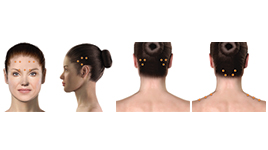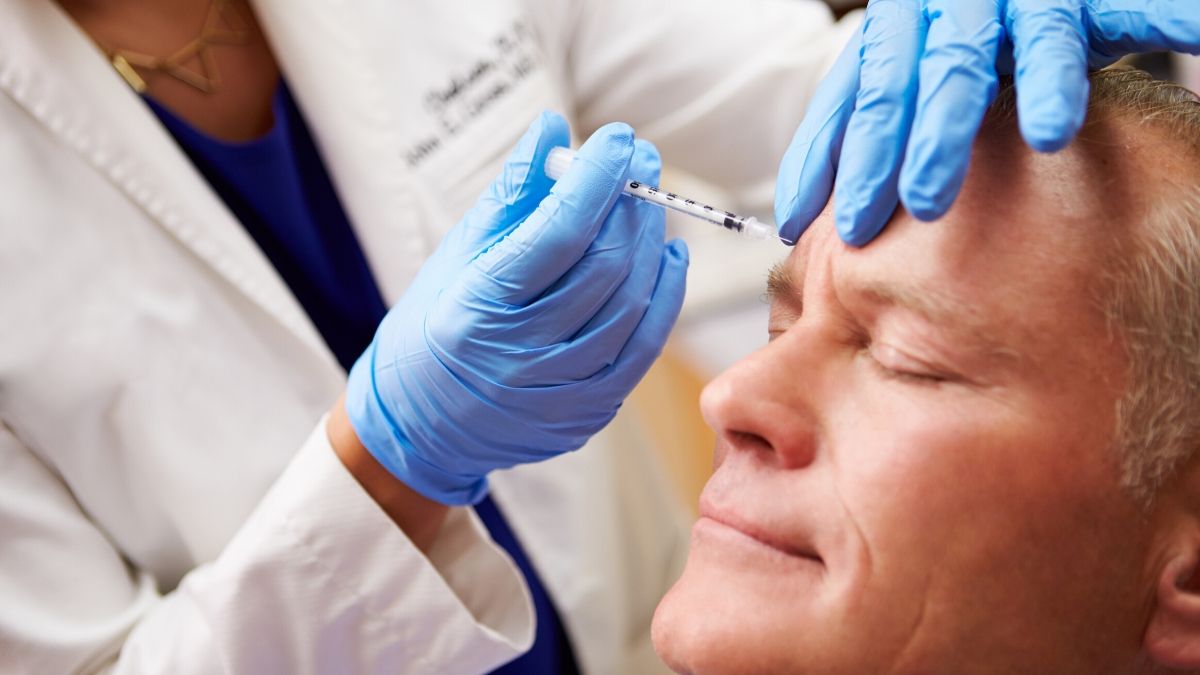You will have your first Botox injections soon. What can you expect?
Can any physician inject Botox for migraine?
Injecting Botox for migraine is not a difficult procedure, but it has to be done by a health care provider with proper training and experience, according to a specific protocol called PREEMPT. When you choose an injector, make sure that the proper protocol is followed, and adapted to your needs. You may use the mychronicmigraine.ca website where you will find a research locator for trained injectors. mychronicmigraine.ca
How are the injections given?
- The procedure takes 10 to 15 minutes.
- The patient may be lying down or sitting.
- There is a precise protocol that the doctor will follow in which 31-39 small volume injections will be given above the eyes, on the forehead, temples, back of the head, top of the neck, and the top of the trapezius.
- Extra injections can be given to target the most painful zones in a safe manner.

Here is a YouTube video with Dr Blumenfeld, top expert in Botox injections. This is a teaching video so there are a lot of details on where to inject. In real life the injections go much faster.
Are the injections painful?
The needles used for Botox injections are very small and a skilled injector will do them fast enough, but needling is never agreeable.
If you have allodynia related to your chronic migraine, or if you are in the midst of an attack, injections can be more painful. Controlling your breathing is a good way to decrease the pain (See this post), especially if you are very nervous. If Botox is effective for you, the likely scenario is that the injections will be easier to tolerate over time.
Are there things I cannot do on the day of the injections?
Always discuss this with your provider as opinions and recommendations may differ slightly.
Many patients receiving Botox just attend the appointment and go on with their normal day.
The following recommendations are often seen in the clinic
- Do not wear a tight helmet or cask after the injections, it may push the Botox down your forehead and lead to cosmetic side effects.
- Do not dye your hair for 48 after the injections, as there have been multiple injections and applying an irritant chemical is not recommended.
- For certain patients, Botox can lead to a soreness due to the needling. It may be wise to avoid exercise and plan for some rest on the day of the injections.
Can I treat my migraine attack on the day of the injection?
Yes, you can use your acute medications as usual. Botox is injected locally and does not interact with medications.
When should I feel the results?
The effect of Botox is not felt immediately after the injections. It takes 7 to 10 days on average. The protein takes time to be transported to the zone where it becomes active. An increase in headaches and neck pain is sometimes seen during the first week after the injections. The effect from the previous treatment has worn off and the new treatment did not kick yet. Discuss this with your physicians to find solutions.
What could I expect as an improvement?
The goal of using Botox is to decrease your migraine frequency (responses do vary from one person to the other). Overall 50% of people who try Botox report a positive response.
Some other signs of response can be noted
- Decrease in intensity
- Better response to acute medications
- Better tolerance to triggers
- Less neck pain
- Less associated symptoms (for example nausea)
What is the wearing off phenomenon?
The duration of the Botox effect is usually 10-12 weeks. Some patients experience an increase in their migraine symptoms prior to their next injections. We call this the wearing off. If this is an issue, discuss with your injector. On the reverse, patients who respond very well to Botox may space their treatments every four months without a recurrence of symptoms.
Will I need Botox all my life? Is it safe?
Migraine is a chronic disease and it may last over your whole life, like diabetes, hypertension and epilepsy. If Botox (or any preventive) is improving your quality of life, you may decide to keep using it. So far, long term use of Botox is not associated with health risks. Minor changes in the bulk of the injected muscles can be seen, for exemple in the temples.
If you want to read about Botox risks and side effects go HERE.
If you want to learn about Botox access and coverage in Canada go HERE.
If you want to read about how Botox works, go HERE.
REFERENCES
- Frampton JE, Silberstein S. OnabotulinumtoxinA: A Review in the Prevention of Chronic Migraine. Drugs. 2018;78(5):589-600.
- Ashkenazi A, Blumenfeld A. OnabotulinumtoxinA for the treatment of headache. Headache. 2013;53 Suppl 2:54-61.
- Dodick DW et al. OnabotulinumtoxinA for treatment of chronic migraine: pooled results from the double-blind, randomized, placebo-controlled phases of the PREEMPT clinical program. Headache. 2010;50(6):921-36.
Post#1203
Tags In
Categories
THE MIGRAINE TREE
- BRANCHES
- ACUTE TREATMENTS
- DEVICES AND NEUROMULATIOIN
- PREVENTIVE TREATMENTS
- PROCEDURES AND INJECTIONS
- SELF-CARE AND LIFESTYLE
- SOCIAL LIFE
- TRUNK
- ROOTS
OTHER CATEGORIES




